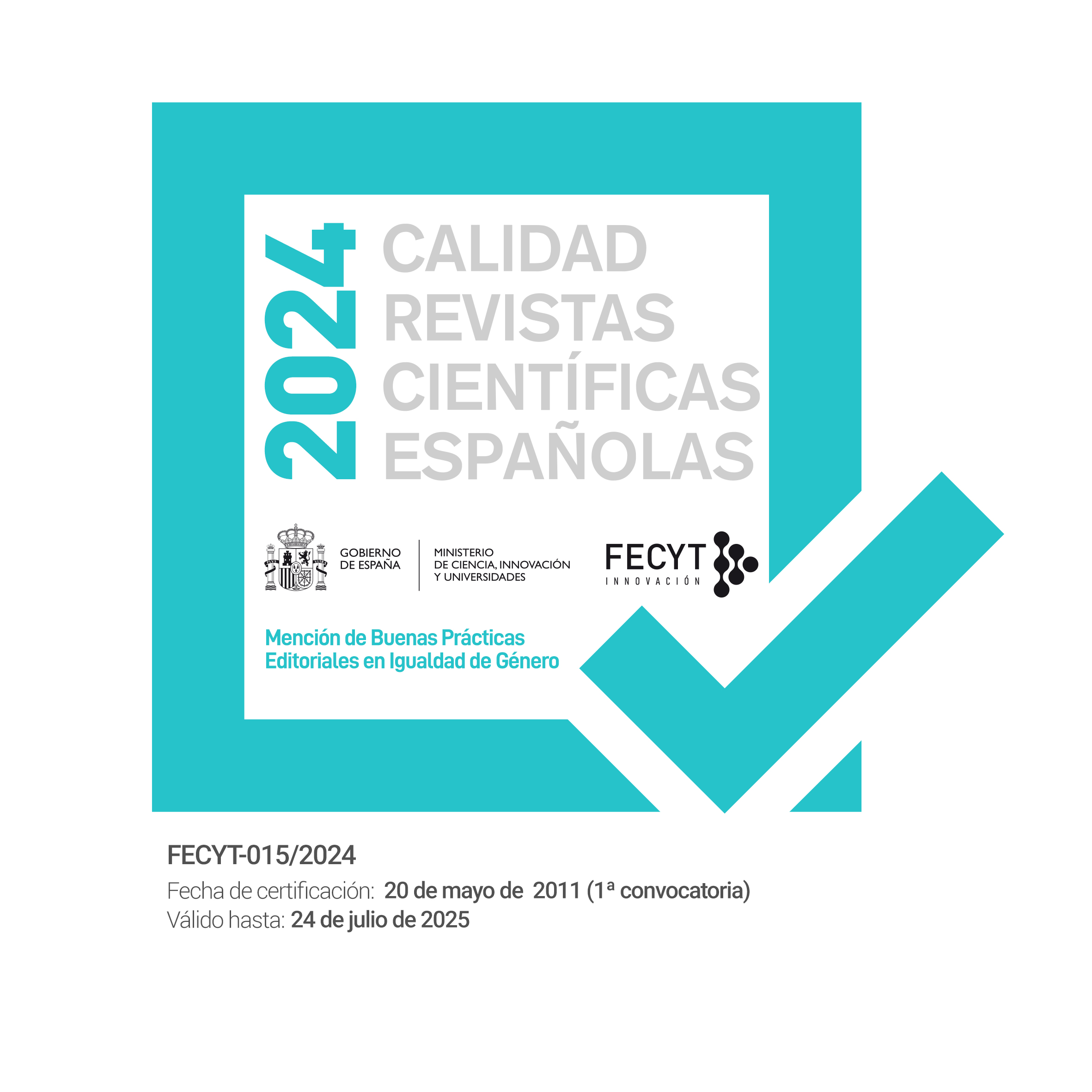对哥伦比亚及墨西哥青年受害者约会暴力问卷(DVQ-R)的验证
##plugins.pubIds.doi.readerDisplayName##:
https://doi.org/10.30827/relieve.v27i2.21963关键词:
情侣暴力, 效度, 信度, 因素结构摘要
因对青年身体健康及精神健康产生的影响,情侣暴力成为如今危害公共健康领域的一大问题,因此拥有能够严谨评测该问题的工具变得至关重要。该研究的目的是验证哥伦比亚及墨西哥青年约会暴力问卷(DVQ-R)的建构效度和信度。研究采用心理统计学,对参与研究的4237名年龄在14到28岁间(平均值=19.44岁,标准差=2.6岁)的哥伦比亚及墨西哥青年进行统计分析。通过克隆巴赫系数计算问卷的信度,得到的内部一致度为α= 0.827。通过探索性因素分析计算建构的效度。根据理论,20个项目被归为5项因素来测量人身暴力、羞辱、性、漠不关心与胁迫这几项迫害行为,结果得到55.1%的总方差。在验证性因素分析中,由5项测量因素构成的模型展示与项目拟合(比较拟合指数=0937,规范拟合指数=0931,增量拟合指数=.937,近似均方根误差=.049)。同时,研究也提出针对哥伦比亚和墨西哥人口对象的额外模型。结果证实约会暴力问卷(DVQ-R)是测量情侣关系迫害行为的适宜工具。
##plugins.generic.usageStats.downloads##
参考
Aizpitarte, A., Alonso-Arbiol, I., Van de Vijver, F. J. R., Perdomo, M. C., Galvez-Sobral, J. A., & Garcia-Lopez, E. (2015). Development of a Dating Violence Assessment Tool for Late Adolescence Across Three Countries: The Violence in Adolescents’ Dating Relationships Inventory (VADRI). Journal of Interpersonal Violence, 1–21. https://doi.org/10.1177/0886260515593543
An, J.H., Moon, C.S., Kim, D.E. et al. (2019). Prevalence of intimate partner violence victimization and its association with mental disorders in the Korean general population. Arch Womens Ment Health 22, 751–758. https://doi.org/10.1007/s00737-019-00997-x
Arnoso, A., Ibabe, I., Arnoso, M., Elgorriaga, E. (2017). El sexismo como predictor de la violencia de pareja en un contexto multicultural, Anuario de Psicología Jurídica, 27(1), 9-20. https://doi.org/10.1016/j.apj.2017.02.001
Bernard, N. K., Levendosky, A. A., Yalch, M. M., & Lannert, B. K. (2019). Interpersonal Style and Posttraumatic Stress Disorder Symptoms in Female Victims of Dating Violence. Violence Vict. 34(3), 522‐535. https://doi.org/10.1891/0886-6708.VV-D-18-00095
Borrego, J. L. C., Rodríguez-Franco, L., & Rodríguez-Díaz, F. J. (2015). Evaluación de la Violencia de Pareja. Una Revisión de Instrumentos de Evaluación Conductual. Revista Iberoamericana de Diagnóstico y Evaluación Psicológica, 1(40), 37–50.
Boomsma, A. (2000). Reporting analyses of covariance structures. Structural Equation Modeling, 7, 461–483. https://doi.org/10.1207/S15328007SEM0703_6
Caselman, T., Dubriwny, N., Curzon, E. L. (2014). Teen dating violence: A comparison of self-report measures. School Social Work Journal, 38(2), 32-48.
Cassepp-Borges, V., & Pasquali, L. (2012). Estudo nacional dos atributos psicométricos da escala triangular do amor de Sternberg. Paidéia, 22(51), 21-31. https://doi.org/10.1590/S0103-863X2012000100004
Caycho, Tomás. (2017). Importancia del análisis de invarianza factorial en estudios comparativos en Ciencias de la Salud. Educación Médica Superior, 31(2), 1-3.
Centers for Disease Control and Prevention, (2020). Preventing Teen Dating Violence. https://www.cdc.gov/violenceprevention/intimatepartnerviolence/teendatingviolence/fastfact.html
Cudeck, R., Jöreskog, K. G., Sörbom, D., & Du Toit, S. (2001). Structural equation modeling: Present and future: A Festschrift in honor of Karl Jöreskog. Scientific Software International.
Demissie, Z., Clayton, H., Vivolo-Kantor, A., & Estefan, L. (2018). Sexual teen dating violence victimization: Associations with sexual risk behaviors among U.S. high school students. Violence & Victimization, 33(5), 964-980. https://doi.org/10.1891/0886-6708.VV-D-17-00124
Dosil, M., Jaureguizar, J., Bernaras, E., & Sbicigo, J. B. (2020). Teen Dating Violence, Sexism, and Resilience: A Multivariate Analysis. Intern journal of environmental research and public health, 17(8), 2652. https://doi.org/10.3390/ijerph17082652
Duval, A., Lanning, B.A., & Patterson, M.S. (2018). A Systematic Review of Dating Violence Risk Factors Among Undergraduate College Students. Trauma, Violence & Abuse, 1-19. https://doi.org/10.1177/1524838018782207
Exner-Cortens, D., Gill, L., & Eckenrode, J. (2016). Measurement of adolescent dating violence: A comprehensive review (Part 1, behaviors). Aggression and Violent Behavior, 27, 64–78. https://doi.org/10.1016/j.avb.2016.02.007
Fernández-Antelo, I., Cuadrado-Gordillo, I., & Martín-Mora Parra, G. (2020). Synergy between Acceptance of Violence and Sexist Attitudes as a Dating Violence Risk Factor. International journal of environmental research and public health, 17(14), 5209. https://doi.org/10.3390/ijerph17145209
Foshee, V. A. (1996). Gender differences in adolescent dating abuse prevalence, types and injuries. Health Education Research, 11(3), 275–286. https://doi.org/10.1093/her/11.3.275-a
García-Cueto, E., Rodríguez-Díaz, F. J., Bringas-Molleda, C., López-Cepero, J., Paíno-Quesada, S., & Rodríguez-Franco, L. (2015). Development of the gender role attitudes scale (GRAS) amongst young Spanish people. International journal of clinical and health psychology, 15(1), 61-68. https://doi.org/10.1016/j.ijchp.2014.10.004
Gómez, M. J., & Rojas-Solís, J. L. (2020). Funcionamiento familiar y violencia de pareja en adolescentes: Un estudio exploratorio. Revista Iberoamericana de Psicología, 12 (3), 35-45. https://doi.org/10.33881/2027-1786.rip.13205
Haglund, K., Belknap, R. A., Edwards, L. M., Tassara, M., Hoven, J. V., & Woda, A. (2019). The Influence of Masculinity on Male Latino Adolescents' Perceptions Regarding Dating Relationships and Dating Violence. Violence against women, 25(9), 1039–1052. https://doi.org/10.1177/1077801218808395
Harman, H. H. Modern factor analysis. Second Edition (Revised). University of Chicago Press, 1967.
Hautala, D. S., Sittner Hartshorn, K. J., Armenta, B., & Whitbeck, L. (2017). Prevalence and Correlates of Physical Dating Violence among North American Indigenous Adolescents. Youth & society, 49(3), 295–317.https://doi.org/10.1177/0044118X14559503
Hokoda, A., Ramos-Lira, L., Celaya, P., Vilhauer, K., Angeles, M., Ruíz, S., Malcarne, V. L., & Mora, M. D. (2006). Reliability of translated measures assessing dating violence among Mexican adolescents. Violence and victims, 21(1), 117–127. https://doi.org/doi:10.1891/vivi.21.1.117
Hossain, M. D., Sultama, A., Fan, Q., Ma, P., & Purohity, N. (2020). Prevalence and Determinants of Dating Violence: An Umbrella Review of Systematic Reviews and Meta-analyses, Advance SageSubmissions. Preprint. https://doi.org/10.31124/advance.11492703.v1
Johns, M. M., Lowry, R., Rasberry, C. N., Dunville, R., Robin, L., Pampati, S., Stone, D. M., & Mercer Kollar, L. M. (2018). Violence Victimization, Substance Use, and Suicide Risk Among Sexual Minority High School Students - United States, 2015-2017. MMWR. Morbidity and mortality weekly report, 67(43), 1211–1215. https://doi.org/10.15585/mmwr.mm6743a4
Kaiser, H. (1974). An index of factorial simplicity. Psychometrika, 39, 31-6. https://doi.org/10.1007/BF02291575
Kim, Y. K., Yu, M., Cronley, C., Yang, M. (2019). Peer victimization, depression, and sexual risk behaviors among high school youth in the United States: a gender-based approach. Int J Adolesc Med Health, 19. https://doi.org/10.1515/ijamh-2019-0139
Lavoie, F., Robitaille, L., & Hébert, M. (2000). Teen Dating Relationships and Aggression: An Exploratory Study. Violence Against Women, 6(1), 6–36. https://doi.org/10.1177/10778010022181688
López-Cepero, J., Fabelo, H. E., Rodríguez-Franco, L., & RodríguezDíaz, F. J. (2016). Validation of the English version of Cuestionario de Violencia de Novios (Dating Violence Questionnaire) on an US college students sample. Violence and Victims. https://doi.org/10.1891/0886-6708.VV-D-14-00077
Martínez Gómez, J. A., Vargas Gutiérrez, R., & Novoa Gómez, M. (2016). Relation between dating violence and parental maltreatment model observation. Psychologia. Avances de la Disciplina, 10(1), 101-112. https://doi.org/10.21500/19002386.2470
McDonald, R. P., & Ho, M.-H. R. (2002). Principles and practice in reporting structural equation analyses. Psychological Methods, 7, 64–82. https://doi.org/10.1037/1082-989X.7.1.64
Molidor, C. E. (1995). Gender differences of psychological abuse in high school dating relationships. Child & Adolescent Social Work Journal, 12(2), 119–134. https://doi.org/10.1007/BF01876208
Moral, J. (2006). Análisis factorial confirmatorio. En R. Landero & M. T. González (Ed.), Estadística con SPSS y Metodología de la investigación (pp. 445-528). Trillas.
Osorio-Guzmán, M. (2014). Propiedades psicométricas del cuestionario maltrato en el noviazgo en una muestra de mujeres estudiantes Mexicanas de nivel medio superior y superior. Salud Pública de Mexico, 56(1), 40–47. https://doi.org/10.21149/spm.v56i1.7321
Pampati, S., Lowry, R., & Steiner, R. J. (2019). Substance use, violence experiences, and mental health issues: are these health risks associated with HIV testing among sexually experienced U.S. high school students? AIDS Care Psychological and Socio-medical Aspects of AIDS/HIV, 31(9), 1106-1113. https://doi.org/10.1080/09540121.2019.1619666
Pasquali, L. (2005). Análise factorial para pesquisadores. Laboratório de Pesquisa em Avaliacao e Medida- LabPam. Brasília, DF. 178-179.
Peña-Cárdenas, F., Zamorano-González, B., Villarreal, S., Vargas, J.I., Velázquez, Y., Hernández-Rodríguez, G. I., Parra, V., y Ruiz, L. (2018). Violencia en el noviazgo en jóvenes y adolescentes en la frontera norte de México. Journal Health NPEPS, 3(2), 426-440. https://doi.org/10.30681/252610103117
Presagy, F., Manca, M., Rodríguez-Franco, L., & Curcio, G. (2015). A questionnaire for the assessment of violent behaviors in young couples: The Italian version of Dating Violence Questionnaire (DVQ). PLOS One, 10.https://doi.org/10.1371/journal.pone.0126089
Rey-Anacona, C. A., Mateus-Cubides, A. M., & Bayona-Arévalo, P. A. (2010). Malos tratos ejercidos por adolescentes durante el noviazgo: Diferencias por sexo. Revista Mexicana de Psicología, 27, 169-181.
Rey-Anacona. C. A. (2013). Prevalencia y tipos de maltrato en el noviazgo en adolescentes y adultos jóvenes. Terapia psicológica 31 (2), 143-154. https://doi.org/10.4067/S0718-48082013000200001
Rodríguez-Díaz, F. J., Herrero, J., Rodríguez-Franco, L., Bringas-Molleda, C., Paíno-Quesada, S. G., & Pérez, B. (2017). Validation of Dating Violence Questionnaire (DVQ-R). International Journal of Clinical and Health Psychology, 17, 77-84. https://doi.org/10.1016/j.ijchp.2016.09.001
Rodríguez-Franco, L., Borrego, J. L., Javier, F., Díaz, R., Molleda, C. B., Bellerín, M. A. A., & Pineda, C. E. (2010). Validation of the Dating Violence Questionnaire, DVQ (Cuestionario de Violencia entre Novios, CUVINO) among Spanish-speaking youth: Analysis of results in Spain, Mexico and Argentina. Anuario de Psicología Clínica y de la Salud, 6, 43–50.
Rojas-Solís, J. L., Fuertes-Martin, J. A., & Orgaz-Baz, M. B. (2017). Dating violence in young Mexican couples: a dyadic analysis. Int. J. Soc. Psychol. 32, 566–596. https://doi.org/10.1080/02134748.2017.1352165
Rubio-Garay, M., López-González, M. A., Carrasco, M. A. & Amor, P. J. (2017). Prevalencia de violencia en el noviazgo: una revisión sistemática. Papeles del Psicólogo/Psychologist Papers, 38(2), 135-147. https://doi.org/10.23923/pap.psicol2017.2831
Sabina, C., Cuevas, C. A., & Cotignola-Pickens, H. M. (2016). Longitudinal dating violence victimization among Latino teens: Rates, risk factors, and cultural influences. Journal of adolescence, 47, 5–15. https://doi.org/10.1016/j.adolescence.2015.11.003
Straus, M. A. (1979). Measuring intrafamily conflict violence: Journal of Marriage and Family, 41(1), 75–88. https://doi.org/10.2307/351733
Straus, M. A., Hamby, S. L., Boney-McCoy, S., & Sugarman, D. B. (1996). The Revised Conflict Tactics Scales (CTS2): Development and preliminary psychometric data. Journal of Family Issues, 17, 283-316. https://doi.org/10.1177/019251396017003001
Smith, J., Mulford, C., Latzman, N. E., Tharp, A. T., Niolon, P. H., & Blachman-Demner, D. (2015). Taking Stock of Behavioral Measures of Adolescent Dating Violence. Journal of Aggression, Maltreatment & Trauma, 24(6), 674–692. https://doi.org//10.1080/10926771.2015.1049767
Straus, M. A. (2004a). Cross-Cultural Reliability and Validity of the Revised Conflict Tactics Scales: A Study of University Student Dating Couples in 17 Nations. Cross-Cultural Research, 38(4), 407–432. https://doi.org/10.1177/1069397104269543
Terrazas-Carrillo, E., & Sabina, C. (2019). Dating Violence Attitudes Among Latino College Students: An Examination of Gender, Machismo, and Marianismo. Violence and victims, 34(1), 194–210. https://doi.org/10.1891/0886-6708.34.1.194
Temple, J. R., Choi, H. J., Elmquist, J., Hecht, M., Miller-Day, M., Stuart, G. L., Brem, M., & Wolford-Clevenger, C. (2016). Psychological Abuse, Mental Health, and Acceptance of Dating Violence Among Adolescents. The Journal of adolescent health: official publication of the Society for Adolescent Medicine, 59(2), 197–202. https://doi.org/10.1016/j.jadohealth.2016.03.034
Toplu-Demirtaş, E., Öztemür, G., Fincham, F. D. (2020). Perceptions of Dating Violence: Assessment and Antecedents. J Interpers Violence, ([published online ahead of print, 2020 Apr 24] https://doi.org/10.1177/0886260520914558
Wolfe, D. A., Scott, K., Reitzel-Jaffe, D., Wekerle, C., Grasley, C., & Straatman, A. L. (2001). Development and validation of the conflict in adolescent dating relationships inventory. Psychological Assessment, 13(2), 277–293. https://doi.org/10.1037//1040-3590.13.2.277
Wincentak, K., Connolly, J., & Card, N. (2017). Teen dating violence: A meta-analytic review of prevalence rates. Psychology of Violence, 7(2), 224–241. https://doi.org/10.1037/a0040194
Yanez-Peñuñuri, L.Y., Hidalgo-Rasmussen, C. A., & Chávez-Flores, Y. V. (2019). Revisión sistemática de instrumentos de violencia en el noviazgo en Iberoamérica y evaluación de sus propiedades de medida, Ciência & Saúde Coletiva, 24(6), 2249-2262. https://doi.org/10.1590/1413-81232018246.19612017
##submission.downloads##
已出版
##submission.howToCite##
期
栏目
##submission.license##
##submission.copyrightStatement##
##submission.license.cc.by-nc4.footer##Los autores ceden de forma no exclusiva los derechos de explotación de los trabajos publicados a RELIEVE (a los solos efectos de favorecer la difusión de los artículos publicados:firmar contratos de difusión, de integración en bases de datos, etc.) y consienten que se distribuyan bajo la licencia de Creative Commons Reconocimiento-Uso No Comercial 4.0 International (CC-BY-NC 4.0), que permite a terceros el uso de lo publicado siempre que se mencione la autoría de la obra y la fuente de publicación, y se haga uso sin fines comerciales.
Los autores pueden llegar a otros acuerdos contractuales adicionales e independientes, para la distribución no exclusiva de la versión del trabajo publicado en esta revista (por ejemplo, incluyéndolo en un repositorio institucional o publicándolo en un libro), siempre y cuando se cite claramente que la fuente original de publicación es esta revista.
La mera remisión del artículo a RELIEVE supone la aceptación de estas condiciones.
















